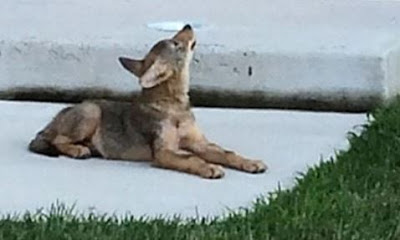An upsurge in coyote sightings
 |
| A coyote pup seen last summer in Falls Church. [FCPD] |
There’s been an increase in coyote sightings in Fairfax County in recent months. The animals are now considered “established and widespread” in the county, states a post in the Fairfax County Police Department blog.
Coyotes could prey on free-range cats and small dogs, so residents are urged to keep pets inside unless they’re being supervised.
Coyotes have been seen throughout the county, including urbanized and residential areas and have been documented in just about all county parks, says FCPD spokesperson Lucy Caldwell.
Recent sightings have occurred in Alexandria, Springfield, and Centreville. Last week animal control officers picked up a coyote that had been hit by a car in Riverside Park in Alexandria. Coyote sightings tend to pick up in December during mating season when lone coyotes are out looking for mates.
There haven’t been any incidents of coyotes attacking people, Caldwell says. Coyotes are generally shy and stay away from humans. They are most active at dusk and dawn, but may be seen in the daytime when they are searching for food or sites for dens.
“Coyotes are opportunistic foragers” who prey on small animals, such as mice, rats, and rabbits but also eat fruits, plants, and carrion, the FCPD states. In residential areas, they might go after small pets, garbage, compost, and pet food.
Katherine Edwards, Fairfax County’s wildlife management specialist, urges residents not to feed coyotes or leave pet food outside, as that might result in coyotes becoming less wary of humans and more aggressive.
Here are some other tips to minimize coyote encounters:
- Keep pets indoors.
- Place garbage and compost in an animal-proof container, such as a metal trash can with latches on the lid.
- Keep trash inside until the morning of trash pick-up.
- Do not let ripe fruit accumulate on the ground.
- Put away bird feeders at night to avoid attracting small rodents and other coyote prey.
- Close up openings under porches, decks, crawl spaces, or out-buildings where animals might establish dens.
- Keep dogs on short leashes (less than six feet) while walking outside.
If you see a coyote, wildlife experts recommend making noise, waving your arms, throwing objects at it, or spraying it with a water hose to scare it away. Other solutions include installing coyote-proof fences, motion-sensing lights, or a motion-activated sprinkler system.
It is illegal to trap and relocate wildlife to another area, the Virginia Department of Game and Inland Fisheries states, although Virginia regulations allow nuisance coyotes to be removed by a “licensed trapper or critter removal service.”
For more information, call the Virginia Wildlife Conflict Helpline, 855-571-9003, weekdays, 8 a.m.-4:30 p.m. If you see a coyote behaving aggressively or appears sick or injured, call the FCPD non-emergency number, 703-691-2131.


https://www.youtube.com/watch?v=ghCTZF61ey0
I lived in San Diego for three years and saw lots of coyotes there. Came home one night and found two coyotes devouring a rabbit on the front lawn. My wife said people should keep their dogs on leashes … I told here they were not dogs. There are no stray cats in San Diego. Not a one.
Awww, he loves Mason District. Must be all the trash that attracts them.
Ellie needs to give an award for the most non-sequitur segue into a comment about Mason's condition.
"Put away bird feeders at night to avoid attracting small rodents and other coyote prey."
The only bird feeder I have is mounted on a second-story window (it's easier to refill and squirrels can't get to it). I cannot imagine anyone taking a feeder that's mounted on a pole or hung in a tree down every evening. Even if it does work, I think it's a ridiculous expectation!